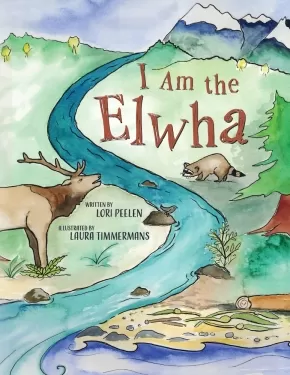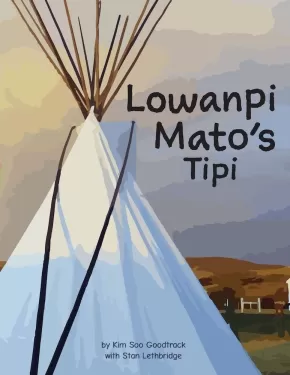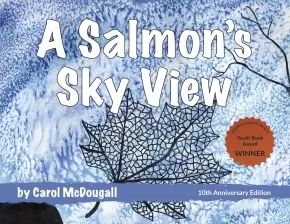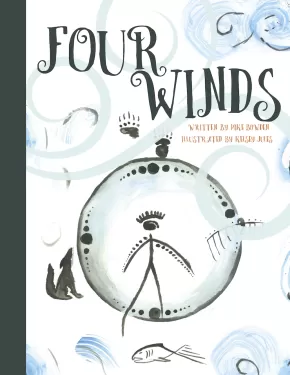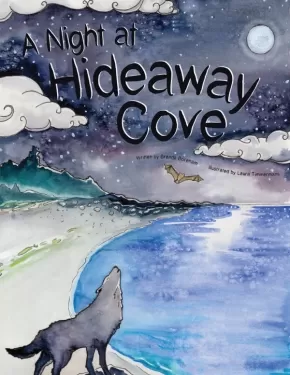
Picture Books
1
-
7
of
7 Results;
Sort By
Powwow Dancing With Family (PB)
 $16.95
$16.95

Artists:
Format:
Paperback
Text Content Territories:
Indigenous Canadian; First Nations; Salish; Interior Salish; Secwepemc (Shuswap);
ISBN / Barcode: 9781771746281
Synopsis:
Synopsis:
Drumming, singing, and dancing are all part of being at a Powwow. Perry and his family travel all over North America to participate in these family and community gatherings. Join Perry’s two boys as they share their treasured memories of being at Powwows with their family and learning how to dance.
Reviews
“Lavishly illustrated with photographs, vivid sketches, and ledger art, Powwow Dancing With Family provides a detailed description of each stage of the Powwow, historical and contemporary aspects of the Powwow, and pays homage to Indigenous culture and customs. This informative resource will support studies of Indigenous culture, history, traditions, community, art, and family lifestyle.” – ERAC Review, May 2019
Educator Information
Includes three pages of educational material on Powwows with information found under these headings:
- What is a Powwow?
- Powwow Regalia
- Powwow Dances
About Perry Smith's Ledger Art:
Ledger Art is an art form that was developed in the mid 1800s to early 1900s by the Plains First Nations during a time when reserves were being established across North America. The ledger books were acquired in trade, war, or raids. New art supplies were also introduced: coloured pencils, crayons, and occasionally water paints. The new supplies were favoured by artists over the traditional bone and stick brushes. Many of the artworks within these ledger books display a traditional way of life, before assimilation. Today these artworks are greatly valued for the historical perspective that they offer.
Additional Information
32 pages | 8" x 8" | ISBN: 9781771746281 | Paperback
I Am the Elwha (HC)
 $18.50
$18.50

Artists:
Format:
Hardcover
Text Content Territories:
Indigenous American; Native American; Salish; Coast Salish; Klallam (Clallam); Lower Elwha Klallam Tribe;
ISBN / Barcode: 9781771744744
Synopsis:
Synopsis:
“I am the Elwha, rushing down to the sea. I am the Elwha, wild and free.”
The Elwha River flows 72 kilometres (45 miles) from its source in the Olympic Mountains to the Strait of Juan de Fuca in the Pacific Northwest. Uniquely, it hosts all six salmon species (Pink, Chinook, Coho, Sockeye, Steelhead, and Chum) as well as several species of trout.
In 1911 two dams were built on the river. The dams blocked the migration routes of the salmon and dramatically altered the entire river ecosystem for 100 years. In 2012 the dams were decommissioned and the world’s largest dam removal and habitat restoration project began.
In this lyrical and beautifully illustrated book, the author chronicles the history of the Elwha. Narrated by the powerful voices of plants and animals that inhabit the river ecosystem, the dam builder, a worker, and the river itself, this story celebrates the ongoing rewilding of this special environment and offers a welcome to all of the creatures who are coming home.
To learn more visit: www.elwha.org
Awards
- 2021 Riverby Award for Young Readers
Reviews
“I Am the Elwha is a powerful read about a powerful river and those who value and protect it." – Raina Delisle, Hakai Magazine
Educator Information
At the back of the book are three pages of cultural, scientific, and historical information that discuss the following:
- the importance and symbolism of salmon to the Lower Elwha Klallam Tribe and other Coastal Salish Tribes
- facts about the six species of salmon found in the Elwha River (Chinook, Pink, Chum, Sockeye, Coho, and Steelhead)
- the history of the Elwha River and its status today
Keywords / Subjects: The Elwha River, Rivers, Dams, History, Environmental Awareness, Lower Elwha Klallam Tribe, Coast Salish, Native American, Culture, Washington, Animals, Salmon, First Salmon Ceremony, Plants, Nature, Settlers, Social Responsibility, Environmental Activism, Poetry.
Recommended for grades 3 to 7.
Additional Information
32 Pages | 8.5" x 11" | ISBN: 9781771744744 | Hardcover
Authenticity Note: This lyrical story, which chronicles the history of the Elwha River, is written by Lori Peelen. Robert Elofson, Tribal Elder and Harvest Manager in the Natural Resources Department for the Lower Elwha Klallam Tribes, approved Lori's work and contributed a few pages of back matter at the end of the work. Lori's story was further approved by Frances Charles, the Tribal Councilwoman for the Lower Elwha Klallam Tribe, after the entire council read and approved it.
The Canadian Content label has been applied because the illustrator of this work is Canadian.
Lowanpi Mato’s Tipi
 $18.50
$18.50

Artists:
Format:
Hardcover
Text Content Territories:
Indigenous Canadian; First Nations; Sioux; Lakota;
ISBN / Barcode: 9781771744751
Synopsis:
Synopsis:
“Hokahe! Welcome!”
Welcome to Wood Mountain, home of the Lakota People, in southern Saskatchewan. It is here that we meet Stan Lethbridge, whose ancestral name is Lowanpi Mato (Singing Bear).
Join Lowanpi Mato as he prepares to set up his summer Tipi. He shares with us Lakota life values and traditions, and how they connect to building and taking care of a Tipi. He teaches us that to build a Tipi you need many items; some are from natural sources and others are purchased from a store. Lowanpi Mato takes us through a step-by-step building process so that we can all learn how a Tipi is built.
The Lakota language is woven throughout the story. The Lakota counting chart on pages 30 and 31 invites you to learn to count and have some fun looking back through the book to find items that match each number.
Welcome to Wood Mountain, home of the Lakota People, in southern Saskatchewan. It is here that we meet Stan Lethbridge, whose ancestral name is Lowanpi Mato (Singing Bear).
Join Lowanpi Mato as he prepares to set up his summer Tipi. He shares with us Lakota life values and traditions, and how they connect to building and taking care of a Tipi. He teaches us that to build a Tipi you need many items; some are from natural sources and others are purchased from a store. Lowanpi Mato takes us through a step-by-step building process so that we can all learn how a Tipi is built.
The Lakota language is woven throughout the story. The Lakota counting chart on pages 30 and 31 invites you to learn to count and have some fun looking back through the book to find items that match each number.
Educator Information
Lakota language is woven throughout this story, as are the seven values of Lakota life.
Lakota language is woven throughout this story, as are the seven values of Lakota life.
Includes a counting chart from 1 to 20 in Lakota, as well as a search-and-find counting game.
Additional Information
32 pages | 8.5" x 11" | Hardcover | ISBN: 9781771744751
32 pages | 8.5" x 11" | Hardcover | ISBN: 9781771744751
A Salmon's Sky View
 $18.50
$18.50

Artists:
Format:
Hardcover
ISBN / Barcode: 9781771744461
Synopsis:
Synopsis:
The ink and watercolour illustrations in this book reflect the life cycle of a salmon from the salmon’s point of view looking up from underwater. Silhouette images provide a clue to the seasons and to the predators the salmon encounters throughout its life. The story reminds us how the salmon demonstrates great determination and strength in its long journey from the stream where life begins, to the ocean, and back to its natal stream.
Carol ends the story with a step-by-step instructional guide to create your own ink and watercolour image.
Educator Information
This is the 10th anniversary edition from CSWA Science in Society award-winning author/illustrator Carol McDougall, B. Ed., M.A. Carol is an international educator and conservationist with decades of classroom and fine arts teaching experience. She conducts workshops on using the arts to help make learning creative and engaging.
Recommended Grades: K-5.
Additional Information
32 pages | 11" x 8.5" | ISBN: 9781771744461 | Hardcover
Four Winds
 $18.50
$18.50

Artists:
Format:
Hardcover
Text Content Territories:
Indigenous Canadian; First Nations; Salish; Interior Salish; Secwepemc (Shuswap);
ISBN / Barcode: 9781771744478
Synopsis:
Synopsis:
A curious Qelmúcw (Person) from the Secwépemc Nation is learning about the world around him with the help of some of his relations. Sk̓elep (Coyote) and Tree guide Qelmúcw in understanding Cmesekst te Snewt (The Four Winds).
Qelmúcw experiences the power of a learning journey using perseverance and courage. He discovers that for meaningful learning to happen he needs to find balance or he could be blown off his learning journey, or even worse, not be completely open to his learning.
This story reflects the reciprocal learning and understanding relationship between a human being and all life and elements (all of relations). It models and reflects the importance of First Peoples’ Principles of Learning: learning is holistic, reflexive, experiential, and relational; learning involves the consequences of one’s actions; learning is embedded in story; and learning involves patience and time. Learning from Indigenous stories can be different and personal every time a story is read or told, depending on context.
Four Winds is the perfect bedtime story or read-aloud in the classroom.
This book works well alongside other books by Mike Bowden and Kelsey Jules, including Chief Goose and Porcupine, and includes a familiar character from Bear and Coyote.
Educator Information
Recommended for grades 3 to 7.
Recommended for grades 3 to 7.
This book is part of the Secwépemc Stories series.
This story is a great resource to introduce Indigenous languages to young readers. Secwepemctsín is one of 30 distinct Indigenous languages in British Columbia and is in the process of being revitalized after governments and religions developed policies to eliminate the rich language and culture of Indigenous peoples. The book integrates Secwépemc words into the text and includes a pronunciation guide on every page. The back of the book includes language resources and a link to an audio pronunciation guide for the Secwépemc alphabet.
This story connects to the BC First Peoples’ Principles of Learning and provides an opportunity for those reading to reflect, explore, connect, and learn on a personal interpretative level.
Curriculum links:
- Social emotional learning: community, helping others, critical thinking, learning from mistakes and trying again
- Reading and language skills
- Indigenous knowledge and traditions
Additional Information
32 Pages | 8.5 " x 11" | ISBN: 9781771744478 | Hardcover
32 Pages | 8.5 " x 11" | ISBN: 9781771744478 | Hardcover
A Night at Hideaway Cove (PB)
 $14.50
$14.50

Artists:
Format:
Paperback
ISBN / Barcode: 9781771743303
Synopsis:
Synopsis:
Come with us, on a mid-August night, to a secluded beach on the Pacific Northwest Coast. There we will meet many creatures that make Hideaway Cove their home. From the black bear to the tiniest beach hopper, we will catch a glimpse of their night-time activities. We will also learn how the moon affects the tides, and explore the intertidal zones.
A Night at Hideaway Cove is a sequel to Hideaway Cove, another exploration of the Pacific Northwest Coast during the daytime. Written by Brenda Boreham, and illustrated by Laura Timmermans, both books share with us the many interconnections within a healthy marine ecosystem.
A Night at Hideaway Cove is a sequel to Hideaway Cove, another exploration of the Pacific Northwest Coast during the daytime. Written by Brenda Boreham, and illustrated by Laura Timmermans, both books share with us the many interconnections within a healthy marine ecosystem.
Reviews
"There are many thoughtful and charming details in both the text and illustrations, such as the moon’s movement across the sky in Laura’s illustrations and the subtle introduction of numbers as the narrative progresses. The moon is a large focus of the story—children will learn about how it affects the tides and what this means for beach creatures like raccoons, who are able to forage for an easy meal amongst the heaps of seaweed left along the shoreline as the tide goes out…. A Night at Hideaway Cove is sure to both delight and inform young readers." – Canadian Teacher Magazine, Winter 2019 issue
"There are many thoughtful and charming details in both the text and illustrations, such as the moon’s movement across the sky in Laura’s illustrations and the subtle introduction of numbers as the narrative progresses. The moon is a large focus of the story—children will learn about how it affects the tides and what this means for beach creatures like raccoons, who are able to forage for an easy meal amongst the heaps of seaweed left along the shoreline as the tide goes out…. A Night at Hideaway Cove is sure to both delight and inform young readers." – Canadian Teacher Magazine, Winter 2019 issue
Educator & Series Information
Each book in the By Day and By Night Nature Series focuses on a scene typical of a distinct west coast habitat, showing how living and non-living things are connected in a healthy ecosystem. As readers, we observe animals going about their daily activities: caring for their young, searching for food, and responding to the changes in light, temperature, and weather conditions throughout the day or night. The last four pages of each book provide facts about the highlighted animals and plants as well as features that are unique to their habitats. The final page suggests ways that young readers and their families can be respectful as they visit wilderness areas.
Readers with a sense of curiosity will find opportunities in these books to:
- use picture clues to predict the featured animal on the next page
- identify, count, and sequence numbers (1 owl, 2 deer, 3 squirrels, etc.)
- search for small creatures that travel from page to page
- discover patterns in the text and structure of the books
- track the movement of the sun, or moon, across the sky
Curriculum Links
Reading - Providing opportunities for guided practise in using reading strategies: visualizing, making connections, asking questions, transforming, and inferring.
Science - Supporting discussion and further exploration:
- characteristics of living things
- needs of living things
- connections between living and non-living things
- daily and seasonal changes
- animal growth and changes
- plant growth and changes
- weather
- habitats
- observable patterns in the sky
Numeracy - Counting and sequencing of numbers 1 to 10.
Social Responsibility - Initiating discussions about ways to take care of wilderness areas.
Search for a mouse that travels from page to page in this story!
Creative Nonfiction: A fictional story with factual information about the Pacific Northwest Coast, as well backmatter that delivers scientific information about the moon, intertidal zones, and seashore creatures.
Additional Information
32 pages | ISBN: 9781771743303 | Paperback
32 pages | ISBN: 9781771743303 | Paperback
The Eagle's Path
 $12.95
$12.95

Artists:
Format:
Paperback
Text Content Territories:
Indigenous Canadian; First Nations; Haudenosaunee (Iroquois); Kanyen'keha:ka (Mohawk);
ISBN / Barcode: 9781771742566
Synopsis:
Synopsis:
Anna explores what it means to be Mohawk, her own identity and the identity of others as she learns to follow the Eagle’s path. She learns how her culture has taught many generations to value honesty, wisdom and courage in their day-to-day lives. Anna also learns about two-spirit people when her best friend tells her that she likes other girls. This revelation leaves her full of questions, and with support from her wise and loving mother, she understands the value in accepting everyone for who they are.
A powerful story to share with children of all ages.
Educator Information
Recommended for Grades 3 to 7.
Additional Information
24 Pages | ISBN: 9781771742566 | Paperback
Sort By




